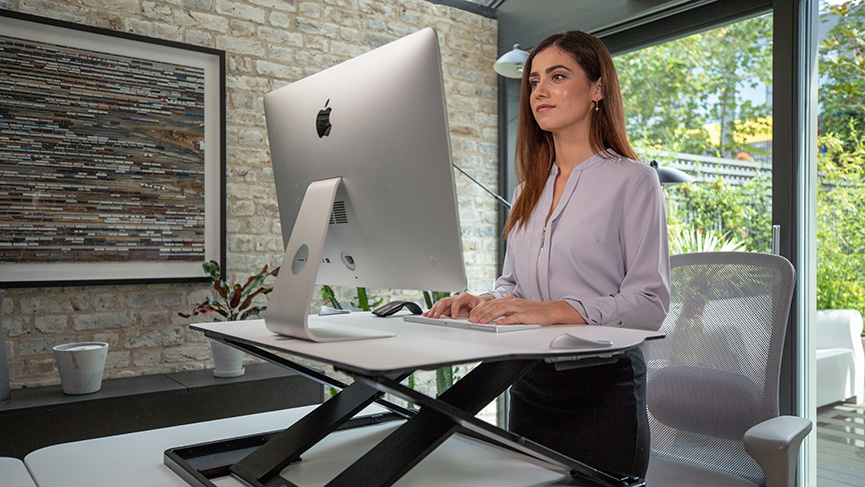
Sleep Routine Tips for a Restful Night
January 8, 2024
The Six Foundational Movements for a Full Body Workout
February 2, 202410 Ways to Progress Your Exercises
We all love our routines, and it is no different when it comes to working out. Whether you do specific workouts on certain days of the week or do the same thing every time you come in, it is a mental relief knowing what to expect from your workouts. Unfortunately, and we have all been there before, our bodies adapt to the workout(s) we are doing and after a while we plateau and do not receive anywhere near the same training stimulus as we did when we first started. This is why it is so important to progress the exercises you are doing in order to continually challenge and improve your overall strength and wellbeing. Below are 10 easy-to-implement ways to spice and progress up your workouts.
- Increase The Resistance
We’ll start with the low hanging fruit here that everyone could have guessed. By increasing the weight of your dumbbells or the resistance of your band you are required to produce more force in order to perform the same exercise. Remember when initially increasing resistance you should also decrease your reps and build your way back up. As a rule of thumb if you can easily do 3 sets of 15 reps of an exercise you can do more weight. When you increase, drop down to 8-10 reps, and work your way back to 15 reps. Rinse and repeat.
Examples
- Increase in 1-10lb increments depending on the exercise
- Use a thicker band or move further away from the anchor point
- Increase The Range-Of-Motion
We all know people who claim they can bench press or squat excessive amounts of weight, but when you actually watch them perform these movements they move through an extremely small range of motion (ROM). While working through small ROMs might allow you to do more weight and boost your ego, you are missing out on massive functional strength benefits by not being able to access greater ranges of motion that are required for sports performance and/or everyday life. Obviously when performing an exercise through a full ROM it should be pain free, which means start with lighter weight to set yourself up for success.
Examples
- Use a heel lift to allow you to squat deeper
- Do hand release pushups to work on pressing through full ROM
- Make The Base of Support Smaller
Simply put, standing on two legs is easier than standing on one. Or to think of it another way, if someone is trying to push you over from the side, a parallel stance is going to offer much more support than a tandem stance where one foot is in front of the other.
Examples
- Perform split stance or single leg squats instead or parallel stance
- Do farmer carries with in-line walking where heel is in line with toe every step
4. Raise The Center of Mass
A tall tree with a skinny trunk is much less stable than a short tree with a stocky trunk. As humans our center of mass is typically located between our navel and sacrum. If we hold dumbbells at our sides our new combined center of mass will move downwards (short stocky tree). If instead we hold that weight on our shoulders, our combined center of mass will move upwards (tall skinny tree). Therefore, when performing exercises, having the weight on our shoulders with a higher combined center of mass requires a much larger demand on core stability in order to perform the exercise properly.
Examples
- Switch from a bodyweight squat to a prisoner squat
- Switch from dumbbell lunges to barbell lunges
5. Move The Resistance Further Away from The Axis of Motion
Try this at home à spin yourself around in your office chair; pull your arms/legs in tight and you will spin fast; extend your arms and legs out and you will slow down; pull them back in again and you will speed back up. The axis of motion is the pole that connects your seat to the legs of the chair. When you keep the weight of your arms/legs close to this axis of motion, resistance is decreased, and you can move easier. Extend those limbs and move their weight further away from the axis and the resistance will increase, making movement harder.
Examples
- Keep arms straight during banded or cable trunk rotations
- For deadlifts switch from using a kettlebell between your legs to a hex bar
6. Add Dynamic Changes to The Base Of Support
If you are performing a split squat you set your feet at the start to establish your base of support and maintain it throughout. To make it more dynamic and challenging you can instead start with your feet together and step back into a reverse lunge, forcing you to reestablish your base of support before each rep. You will be surprised how hard it is to land your foot in the same spot each time.
Examples
- Switch from a split squat to a reverse lunge
- Instead of a medball chest pass do a medball squat into a chest pass
7. Reduce The Number of Points of Stability
We’ve all sat in a wobbly chair or had an uneven table at a restaurant. As frustrating as it is this is a great visual for understanding this concept. If you are in a plank position with both forearms and feet on the ground, you feel sturdy. Lift one of those forearms off, or maybe even an opposite forearm and foot, and you now might feel like the wobbly table as your torso and hips start rotating and the imaginary glass of water on your lower back spills off. In this example, when we reduce the number of limbs on the ground forcing our core and stabilizing muscles to have to work exponentially harder to develop a new strategy in order to stay level.
Examples
- Switch from regular pushups to 1 leg pushups
- Perform a bird dog row off the bench
- When dumbbell bench pressing only have your head and back on the bench so you have to push through your feet and glutes for stability
8. Use An Unstable Surface
If you have done any sort of lower body rehab you have most likely had to stand on an unstable pad while performing your exercises and you know how challenging this little addition can be. While I am a fan of these unstable surfaces, I have found it to be enough of a challenge for my clients just to remove their shoes and do exercises barefoot. Our shoes today are marketed to us based on how comfy, soft, and supportive they are. And while it feels nice wearing them around during long days on our feet, they essentially allow all of the muscles and ligaments and tendons in our feet to go on vacation, which is a massive precursor to chronic injuries down the road. If your feet and ankles are not efficient at absorbing and redirecting force (their main purpose) then that force gets passed up the chair to your knees, hips, and/or back.
Examples
- Go barefoot more frequently throughout your day
- Do squats, lunges, farmer carries without your shoes
- Stand on an unstable pad for foot and ankle exercise
9. Apply Destabilizing Torques to The Body
Have you ever been walking on a heeling sailboat or in a strong crosswind? If so, you know how much harder you have to work in order to maintain an upright posture while you walk. These destabilizing torques courtesy of mother nature are a great, albeit extreme, example of the destabilizing torques we can encounter in our everyday lives. Dog pulling on the leash, toddler squirming in your arms, standing on a crowded subway, trying to absorb or fight off body contact in sports. I’m sure you can think of many more that are applicable to you and if we encounter these things daily then it makes sense to train in a way to prepare us for them.
Examples
- Do a 1-arm farmer carry instead of a two-armed version
- Put an anchored band around your waist and do lateral shuffles
- Squat holding a kettlebell in one arm instead of centered in both
- Put an extra 10lbs on one side of the bar during bench presses or squats
10. Use Tempos
This is easily my favorite, and most humbling, way to progress an exercise. For every exercise that involves movement there is an eccentric phase, isometric phase, and concentric phase. Let’s use the squat as an example. The eccentric phase occurs during the lowering portion of the movement as we squat down. The isometric phase occurs at the very bottom end range of the squat before we start to ascend. And the concentric phase is when we start rising until we return to standing at the top. This example holds true for most exercises so think…Eccentric = Lowering…Isometric = End Range…Concentric = Rising. The most common and easiest way to squat (and you do it without thinking about it) is to lower down for 1sec, spend 0sec at the end range, and then rise back up for 1sec. Forcing yourself to go slower or faster during any of these three phases is going to drastically change the demands your muscles have to overcome in order to maintain good form while successfully performing the exercise. And discovering a weakness during one of these phases and then practicing getting better at is the best way to quickly increase strength!
Examples
- when squatting lower down for 3sec and/or pause at the bottom for 3sec
- when doing pushups drop down fast and pause for 3sec at the bottom then push up fast
As you now know there are numerous ways to progress and vary exercises to keep things challenging and interesting as you continue your fitness journey. There is always room for improvement and if you feel stuck in a routine that feels like it is not providing the same benefits it used to, give some of these variations a try or schedule a personal training session with one of our specialists.
Onwards and upwards!
Garrett Withiam, ATC
Assistant Director of Health & Fitness
Personal Training Manager




